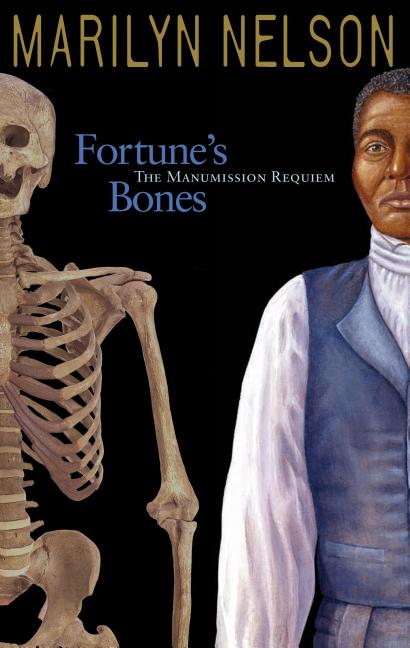Book Descriptions
for Fortune's Bones by Marilyn Nelson
From Cooperative Children's Book Center (CCBC)
In 1798 a slave called Fortune died at the age of sixty. He had been owned by a doctor who preserved his skeleton, rather than burying him, and passed the skeleton on through four generations of doctors in his family. Years later, the bones ended up in a museum in Waterbury, Connecticut, where they were on public display for decades. By then, little was known about the skeleton, which had playfully been renamed Larry. Historical research was initiated in 1996 to learn more about the skeleton – who he had been and what his life was like. After learning Fortune’s history, the museum commission poet Marilyn Nelson to write a requiem for him. As she did in her book, Carver: A Life in Poems (Front Street, 2001), Nelson has written poems from multiple viewpoints. There is Fortune’s wife, Dinah, who had to dust his bones as part of her regular household duties; Dr. Porter, who prepared the skeleton for his own academic use; various people who encountered the skeleton over the generations; and Fortune himself: “You are not your body, / You are not your bones. / What’s essential about you / is what can’t be owned.” Historical background notes, photographs and drawings accompany the text of this slender and thought-provoking volume. (Ages 12–18)
CCBC Choices 2005 . © Cooperative Children's Book Center, Univ. of Wisconsin - Madison, 2005. Used with permission.
From the Publisher
Winner of the Coretta Scott King Book Award
For young readers comes a poetic commemoration of the life of an 18th-century slave, from a past poet laureate and three-time National Book Award finalist
For over 200 years, the Mattatuck Museum in Connecticut has housed a mysterious skeleton. In 1996, community members decided to find out what they could about it. Historians discovered that the bones were those of an enslaved man named Fortune, who was owned by a local doctor. After Fortune’s death, the doctor rendered the bones.
Further research revealed that Fortune had married, had fathered four children, and had been baptized later in life. His bones suggest that after a life of arduous labor, he died in 1798 at about the age of 60. The Manumission Requiem is Marilyn Nelson’s poetic commemoration of Fortune’s life. Detailed notes and archival photographs enhance the reader’s appreciation of the poem.
For young readers comes a poetic commemoration of the life of an 18th-century slave, from a past poet laureate and three-time National Book Award finalist
For over 200 years, the Mattatuck Museum in Connecticut has housed a mysterious skeleton. In 1996, community members decided to find out what they could about it. Historians discovered that the bones were those of an enslaved man named Fortune, who was owned by a local doctor. After Fortune’s death, the doctor rendered the bones.
Further research revealed that Fortune had married, had fathered four children, and had been baptized later in life. His bones suggest that after a life of arduous labor, he died in 1798 at about the age of 60. The Manumission Requiem is Marilyn Nelson’s poetic commemoration of Fortune’s life. Detailed notes and archival photographs enhance the reader’s appreciation of the poem.
Publisher description retrieved from Google Books.


